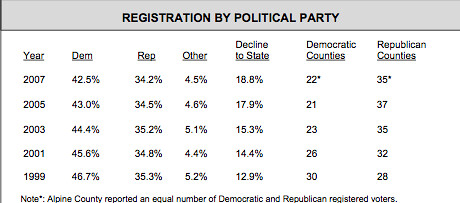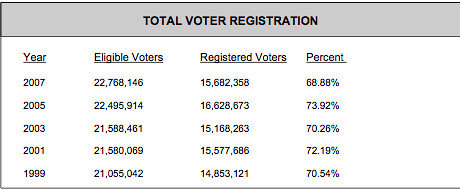(cross-posted from MyDD. It is a compilation of a few posts I have written in recent weeks.)
It is interesting to see the national trends towards independents Chris Bowers just wrote about. Here in California the trend is more pronounced towards DTS (decline to state). Democrats are losing a lot more ground than Republicans. This is the most recent chart from the CA Secretary of State.

DTS is up almost 6 points in 8 years. Democrats have dropped 4.2% and Republicans 1.1%. The highest number percentage of DTS voters are in San Francisco (29.13%) Mono (24.34%) and Alpine (22.98%).
Overall registration is dropping, now below 70%. These are not positive long term trends.

This combined with a very strong trend towards permanent absentee (now at 3.9 million voters) is really changing how campaigns are run in California. It is likely that over half of all voters will vote absentee in the primary. We were at 47% for the primary last spring. That number is only supposed to grow.
These two trends will have a direct impact on the presidential primary.
For one, the Republicans are not permitting DTS voters to participate in their primary. They are allowed in the Democratic primary. This should skew it slightly right for the Republicans and more moderate for the Democrats. Californians who are registered as permanent absentee voters get their ballots and begin voting on January 7th, well before the Iowa Caucuses. For more analysis see my earlier post.

The Republican primary is even more quirky. They are allocating delegates based on how candidates do in individual Congressional districts. This effectively turns California into 53 distinct campaigns. And with district Republican registration swinging between 199,747 (CA-48) and 27,025 (CA-31) this makes some Republican votes worth much more than others.
The Democratic primary by contrast is much more straight forward. We are starting to see the different campaign’s approach to California based on their early staff hires and campaign appearances. By far, Clinton is investing the most resources into organizing California. She is staffing up. Clinton now has a State Director, Political Director, Communications Director, Field Director and Deputy Field Director, all in California. They have extensive history working here, especially down in vote rich LA.
Edwards was out here this week for an appearance at Google and a small dollar fundraiser in San Jose last night. He has hired a CA fundraiser, but I have not seen any news of any other staff allocations.
Obama has hired the Pasadena based The Strategy Group. Larry Grisolano goes back a long ways with Obama and is a well respected California consultant.
Richardson declared out here and is emphasizing his a Latino and Californian roots. I have not seen any indication that he has done any California specific hiring.
To run an effective campaign in California you need a lot of money for advertising, think $2-3 million for a week of statewide television saturation. Then there is rado. You must have a direct mail guru who can target the DTS and likely Democrats, backed with a robust voter file. Successful campaigns will run a sophisticated absentee voter campaign with targeted mailings and phone calls. Voters who turn in their ballots can be crossed off lists. Door knocking is just as effective here as in any other state, but there is a ton of ground to cover and this requires a lot of time and volunteers.
There are a ton of delegates up for grabs, but campaigns will have to put a lot of resources into running an effective campaign. Thus far, Clinton is by all indications making that investment. Will we see the others step up? She is showing a strong lead in the polls but there is an opportunity for someone on the left to compete directly with her. Who will that be?
